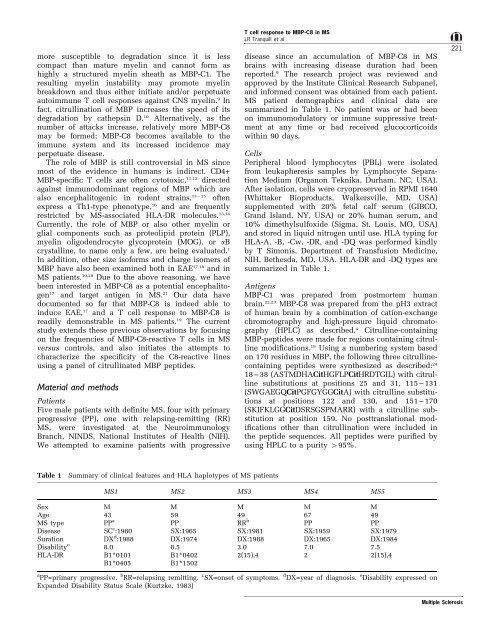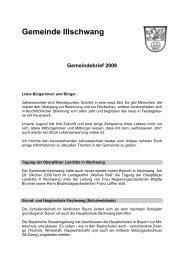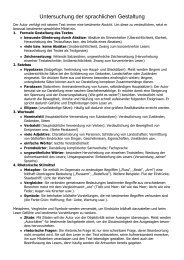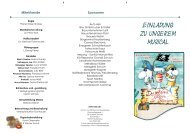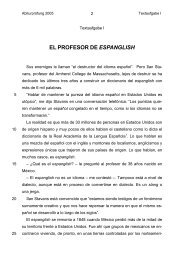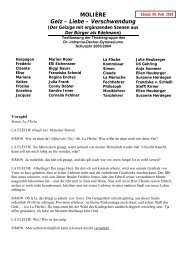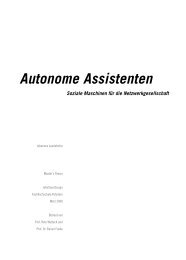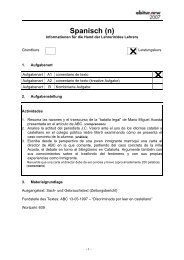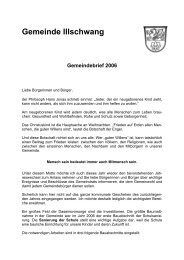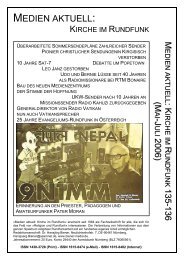Enhanced T cell responsiveness to citrulline-containing ... - Asamnet
Enhanced T cell responsiveness to citrulline-containing ... - Asamnet
Enhanced T cell responsiveness to citrulline-containing ... - Asamnet
You also want an ePaper? Increase the reach of your titles
YUMPU automatically turns print PDFs into web optimized ePapers that Google loves.
more susceptible <strong>to</strong> degradation since it is less<br />
compact than mature myelin and cannot form as<br />
highly a structured myelin sheath as MBP-C1. The<br />
resulting myelin instability may promote myelin<br />
breakdown and thus either initiate and/or perpetuate<br />
au<strong>to</strong>immune T <strong>cell</strong> responses against CNS myelin. 9 In<br />
fact, citrullination of MBP increases the speed of its<br />
degradation by cathepsin D. 10 Alternatively, as the<br />
number of attacks increase, relatively more MBP-C8<br />
may be formed; MBP-C8 becomes available <strong>to</strong> the<br />
immune system and its increased incidence may<br />
perpetuate disease.<br />
The role of MBP is still controversial in MS since<br />
most of the evidence in humans is indirect. CD4+<br />
MBP-speci®c T <strong>cell</strong>s are often cy<strong>to</strong><strong>to</strong>xic, 11,12 directed<br />
against immunodominant regions of MBP which are<br />
also encephali<strong>to</strong>genic in rodent strains, 13 ± 15 often<br />
express a Th1-type phenotype, 16 and are frequently<br />
restricted by MS-associated HLA-DR molecules. 13,14<br />
Currently, the role of MBP or also other myelin or<br />
glial components such as proteolipid protein (PLP),<br />
myelin oligodendrocyte glycoprotein (MOG), or aB<br />
crystalline, <strong>to</strong> name only a few, are being evaluated. 1<br />
In addition, other size isoforms and charge isomers of<br />
MBP have also been examined both in EAE 17,18 and in<br />
MS patients. 19,20 Due <strong>to</strong> the above reasoning, we have<br />
been interested in MBP-C8 as a potential encephali<strong>to</strong>gen<br />
17 and target antigen in MS. 21 Our data have<br />
documented so far that MBP-C8 is indeed able <strong>to</strong><br />
induce EAE, 17 and a T <strong>cell</strong> response <strong>to</strong> MBP-C8 is<br />
readily demonstrable in MS patients. 19 The current<br />
study extends these previous observations by focusing<br />
on the frequencies of MBP-C8-reactive T <strong>cell</strong>s in MS<br />
versus controls, and also initiates the attempts <strong>to</strong><br />
characterize the speci®city of the C8-reactive lines<br />
using a panel of citrullinated MBP peptides.<br />
Material and methods<br />
Patients<br />
Five male patients with de®nite MS, four with primary<br />
progressive (PP), one with relapsing-remitting (RR)<br />
MS, were investigated at the Neuroimmunology<br />
Branch, NINDS, National Institutes of Health (NIH).<br />
We attempted <strong>to</strong> examine patients with progressive<br />
Table 1 Summary of clinical features and HLA haplotypes of MS patients<br />
Sex<br />
Age<br />
MS type<br />
Disease<br />
Suration<br />
Disability e<br />
HLA-DR<br />
disease since an accumulation of MBP-C8 in MS<br />
brains with increasing disease duration had been<br />
reported. 9 The research project was reviewed and<br />
approved by the Institute Clinical Research Subpanel,<br />
and informed consent was obtained from each patient.<br />
MS patient demographics and clinical data are<br />
summarized in Table 1. No patient was or had been<br />
on immunomodula<strong>to</strong>ry or immune suppressive treatment<br />
at any time or had received glucocorticoids<br />
within 90 days.<br />
Cells<br />
Peripheral blood lymphocytes (PBL) were isolated<br />
from leukapheresis samples by Lymphocyte Separation<br />
Medium (Organon Teknika, Durham, NC, USA).<br />
After isolation, <strong>cell</strong>s were cryopreserved in RPMI 1640<br />
(Whittaker Bioproducts, Walkersville, MD, USA)<br />
supplemented with 20% fetal calf serum (GIBCO,<br />
Grand Island, NY, USA) or 20% human serum, and<br />
10% dimethylsulfoxide (Sigma, St. Louis, MO, USA)<br />
and s<strong>to</strong>red in liquid nitrogen until use. HLA typing for<br />
HLA-A, -B, -Cw, -DR, and -DQ was performed kindly<br />
by T Simonis, Department of Transfusion Medicine,<br />
NIH, Bethesda, MD, USA. HLA-DR and -DQ types are<br />
summarized in Table 1.<br />
Antigens<br />
MBP-C1 was prepared from postmortem human<br />
brain. 22,23 MBP-C8 was prepared from the pH3 extract<br />
of human brain by a combination of cation-exchange<br />
chromo<strong>to</strong>graphy and high-pressure liquid chroma<strong>to</strong>graphy<br />
(HPLC) as described. 4 Citrulline-<strong>containing</strong><br />
MBP-peptides were made for regions <strong>containing</strong> <strong>citrulline</strong><br />
modi®cations. 19 Using a numbering system based<br />
on 170 residues in MBP, the following three <strong>citrulline</strong><strong>containing</strong><br />
peptides were synthesized as described: 24<br />
18 ± 38 (ASTMDHACitHGFLPCitHRDTGIL) with <strong>citrulline</strong><br />
substitutions at positions 25 and 31, 115 ± 131<br />
(SWGAEGQCitPGFGYGGCitA) with <strong>citrulline</strong> substitutions<br />
at positions 122 and 130, and 151 ± 170<br />
(SKIFKLGGCitDSRSGSPMARR) with a <strong>citrulline</strong> substitution<br />
at position 159. No posttranslational modi®cations<br />
other than citrullination were included in<br />
the peptide sequences. All peptides were puri®ed by<br />
using HPLC <strong>to</strong> a purity 495%.<br />
MS1 MS2 MS3 MS4 MS5<br />
M<br />
43<br />
PP a<br />
SC c :1980<br />
DX d :1988<br />
8.0<br />
B1*0101<br />
B1*0405<br />
M<br />
59<br />
PP<br />
SX:1965<br />
DX:1974<br />
8.5<br />
B1*0402<br />
B1*1502<br />
T <strong>cell</strong> response <strong>to</strong> MBP-C8 in MS<br />
LR Tranquill et al<br />
M<br />
49<br />
RR b<br />
SX:1981<br />
DX:1988<br />
3.0<br />
2(15),4<br />
M<br />
67<br />
PP<br />
SX:1959<br />
DX:1965<br />
7.0<br />
2<br />
M<br />
49<br />
PP<br />
SX:1979<br />
DX:1984<br />
7.5<br />
2(15),4<br />
a b c d e<br />
PP=primary progressive. RR=relapsing remitting. SX=onset of symp<strong>to</strong>ms. DX=year of diagnosis. Disability expressed on<br />
Expanded Disability Status Scale (Kurtzke, 1983)<br />
221<br />
Multiple Sclerosis


